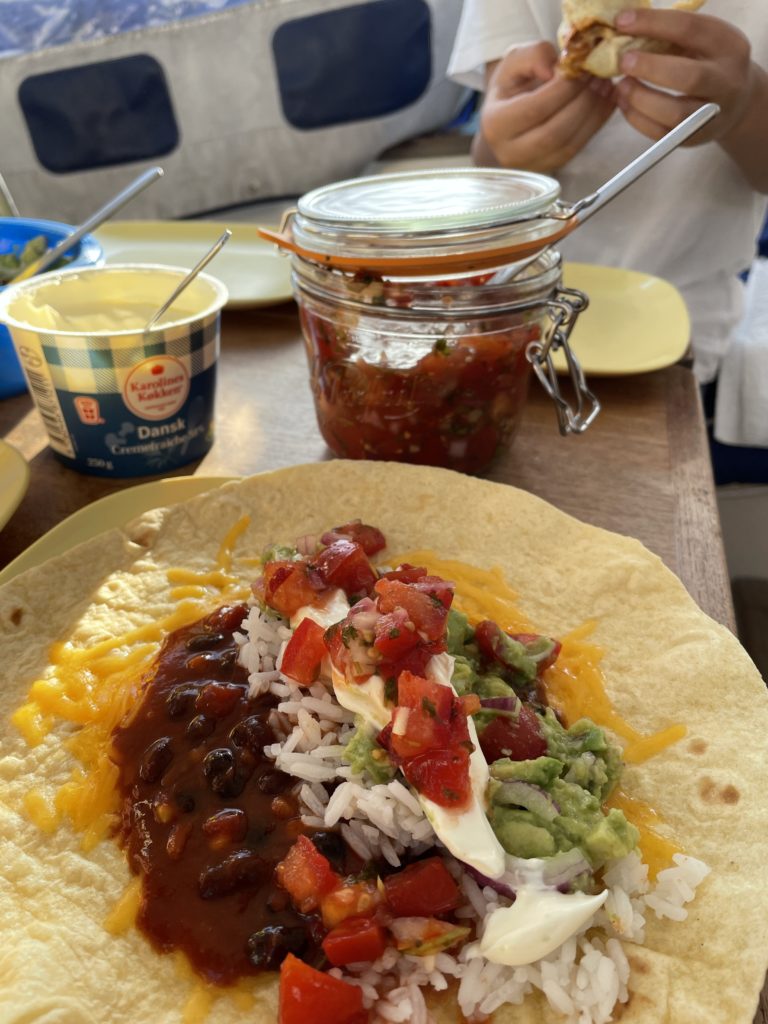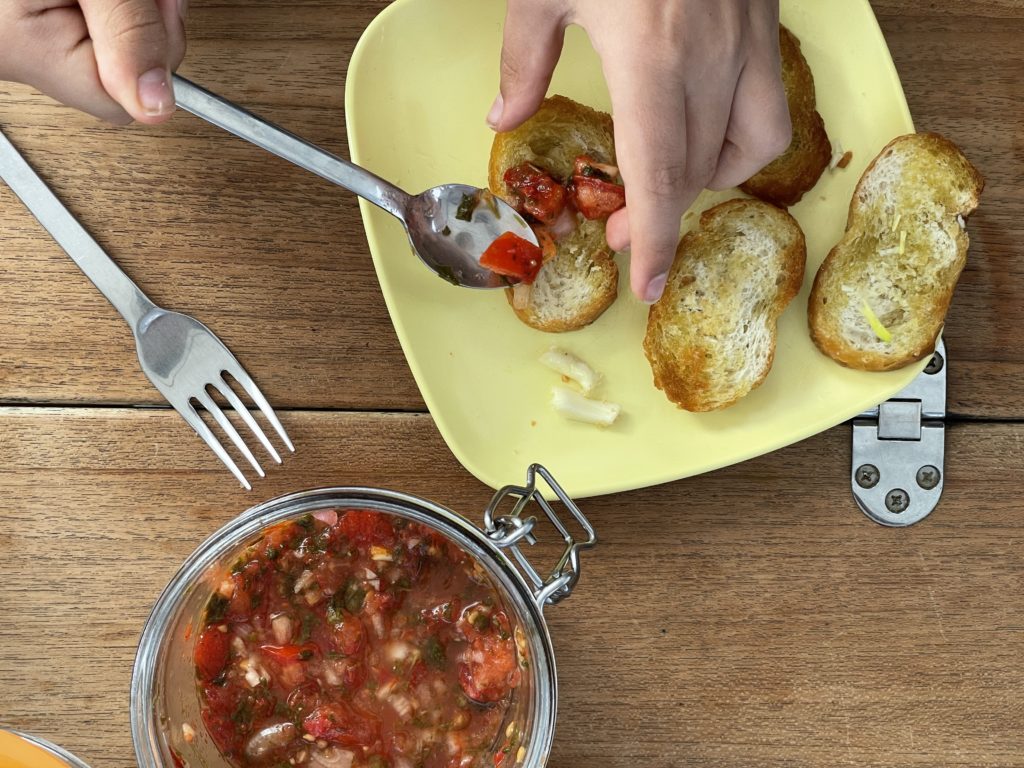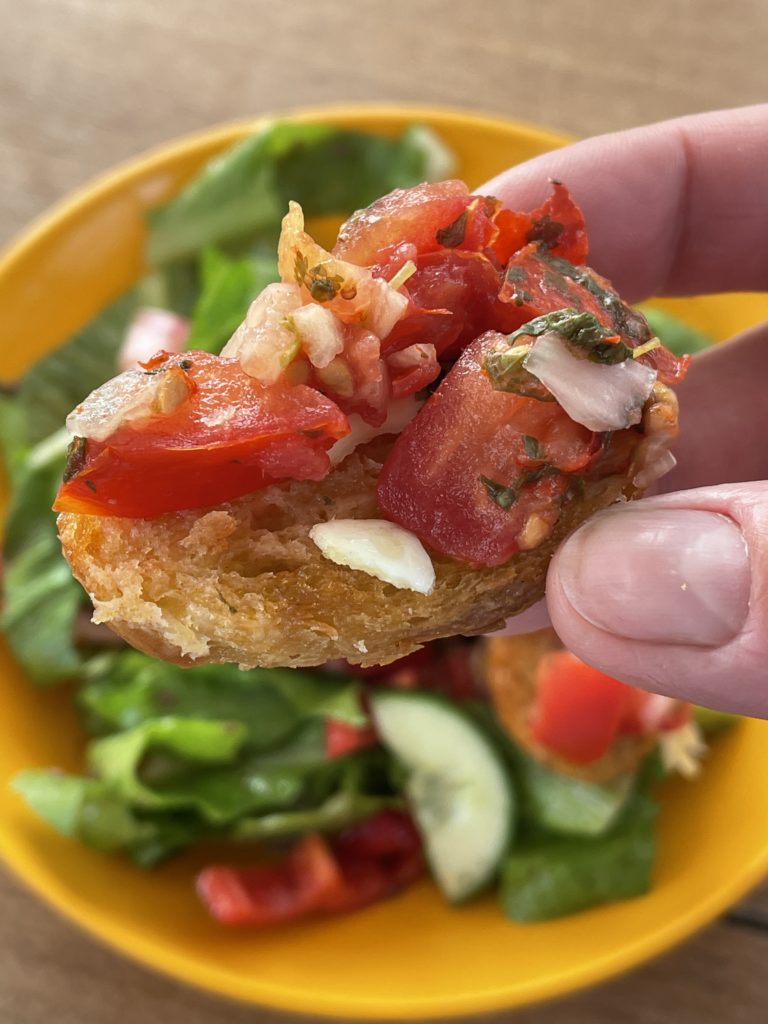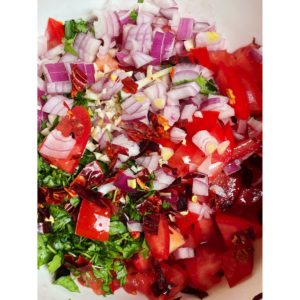For fermented tomato salsa you first of all need aromatic tomatoes. Without ripe produce, this ferment will not taste good, which is why you should only prepare it in season. In Germany, fermented tomato salsa is a summer ferment. When shopping, give preference to regional varieties that are optimally adapted to the weather. This way you promote the diversity of varieties and can also enjoy the fullest flavor. You can find regional varieties at the farmer's market, the grocery market, and often even at the supermarket.
Fully ripe, regional tomatoes are the basis of this ferment
I am lucky to be able to grow my own tomatoes in my urban garden. One of my favorite varieties is the Vierländer Platte, a historical tomato variety that has been available since the end of the 19th century in the Vierlanden near Hamburg. It really doesn't get any more regional for me.



The flat, slightly ribbed fruits have a red-orange color, delicately melting pulp and are surrounded by a fragile skin. The taste is fruity with a fine acidity and the typical tomato taste.
Due to their thin skin, these tomatoes are not suitable for trade. In order to save them from extinction, I not only grow them myself, but also give seeds and early plants to other hobby gardeners every year.
The Vierländer Platte is a candidate for the ark of taste
The project "Ark of Taste" of the Slow Food Foundation for Biodiversity protects regionally important foods, farm animal species, cultivated plants and traditional preparation methods worldwide from forgetting and disappearing. In the current food system, they are considered unprofitable or "out of fashion" due to their comparatively complex production or rearing.
Regional tomatoes are the most widely eaten vegetable in Germany, although the climate is certainly not ideal for growing tomatoes. The Vierländer Platte is a local variety in and around Hamburg that has become reasonably accustomed to the weather and has a fine acidic flavor. Unfortunately, the yields of Vierländer Platten are much lower than those of the less flavorful new varieties, so there is a danger that this old variety will disappear for good. Only what is eaten remains.
Source: Slow Food Deutschland
The Vierländer Platte must be consumed quickly when ripe because it can only be stored for a short time, this wonderful, regional connoisseur variety.
Because of the shorter shelf life, I prefer to eat them fresh - as a salad, raw food or antipasti. Or of course as a quick fermented tomato salsa! Because this delicious ferment tastes best after only a few days.
What if the fermented tomato salsa is overfermented?
If you forget the salsa in the fridge and it is quite sour after more than three weeks, I recommend combining it with a fat burrito, with lots of cheese and sour cream. The flavors complement each other wonderfully and you don't have to waste any of your precious salsa. Plus, the lacto-fermented salsa helps you digest the fatty food.



Bruschetta recipe with fermented tomato salsa
For this recipe it tastes good if you prepare the salsa with basil (and possibly some fresh oregano). You can also add these herbs when preparing the bruschetta.
Ingredients for an appetizer for 2 people
- 6-8 small slices of ciabatta
- 3-4 tbsp extra virgin olive oil
- 2 cloves of garlic
- 6-8 tbsp fermented tomato salsa
- salt & pepper
Roast the slices of bread in the pan with half of the oil from both sides. Rub with the peeled garlic cloves, salt and sprinkle with the remaining oil. Add a tablespoon of fermented tomato salsa to the pieces of bread and season with freshly ground pepper.
Serve warm.




Hallo, vielen Dank für die tolle Seite. Ich mache mit dem Tomatensalsa mein erstes Ferment. Eine Frage habe ich: Wieso wird das täglich umgerührt und also geöffnet? (Ich nutze ein Weckglas mit Klammer.) Beste Grüße!
Hej Tina,
danke, dass Dir die Seite gefällt!
Die Salsa muss gerührt werden, weil die kleinen Teile nicht unter der Lake bleiben und sonst schimmeln würden. Deshalb bricht man die Oberfläche täglich 1-2 Mal. Außerdem kann man dann gut probieren, wann sie schmeckt.
Für dieses Ferment ist ein Schraubglas gut geeignet, weil es sich so simpel öffnen lässt. Das Weckglas geht natürlich auch, wenn es Dich nicht nervt 😉
Gutes Gelingen!
Katsu
Hallo,
Ich habe mich jetzt durch diese tolle Seite“gearbeitet“ und möchte mich als erstes an der Tomatensalso versuchen.Meine Frage dazu wäre, die Tomenten werden entkernt, oder nicht ?
Wenn ich ein Schraubglas benutze, oxidiert der Deckel dann nicht ?
Beste Grüsse
Hej Suzan,
danke, dass Dir gefällt, was ich hier mache.
Wenn es Dir besser schmeckt, kannst Du die Tomaten gerne entkernen, ich mache mir die Mühe nicht. Nötig ist es auf keinen Fall.
Du hast Recht, der Deckel des Glases würde oxidieren, wenn das Ferment damit in Berührung käme. Am besten machst Du es nicht so voll. Dann geht auch das tägliche Rühren besser.
Gutes Gelingen!
Katsu
Hallo Katsu
Tolle Seite, interessante Rezepte. Werd die Zwetschgen ausprobieren. Jetzt gibt es die besten Fränkischen….
Liebe Grüße aus Kulmbach
P.S.: Rotkraut hab ich letzten Winter fermenteirt, aber diese Gewürzmischungen aus Georgien reizen mich sehr. Danke
Hej Susanne,
ich freue mich, dass Du hier gute Rezepte und Inspirationen findest. In Franken wäre ich jetzt auch gerne, leider komme ich erst wieder im November hin.
Genieße den fränkischen Herbst!
Mit Gruss aus Hamburg,
Katsu
Hallo Katsu,
es wird nicht saurer, ich habe jetzt ein Glas von letztem Jahr aufgemacht, das Aroma ist toll, nur hat es viel Wasser gezogen. Welches aber einen herrlichen Umami-Geschmack hat und weiterverwendet wird!
Hej Ingrid,
dass es nicht sauer ist, klingt gar nicht gut. Denn nur, weil ein Essen gut schmeckt, heisst das nicht, dass es auch sicher ist. Bei Gemüsefermenten muss der pH-Wert niedrig genug sein, damit sich schädliche Bakterien wie C.Botulinum nicht vermehren können. Wenn der pH-Wert nicht niedrig genug ist, empfehle ich, das Ferment nicht zu essen.
Um sicherzustellen, dass dein fermentiertes Essen gelingt, verwendest Du 2% Salz. Das Gemüse sollte stets bedeckt sein und innerhalb von 2-3 Tagen zu fermentieren beginnen. Der pH-Wert sollte analog dazu auf 4,5 sinken. Wenn es länger als eine Woche dauert, oder der pH-Wert über 5 liegt, solltest du es lieber wegschmeißen.
Falls es nur nicht sauer schmeckt, der pH aber niedrig genug ist, ist alles gut. Bitte überprüfe das unbedingt!
Katsu
Du hast mich falsch verstanden, ich schrieb “es wird nicht saurER”, also genauso sauer wie nach 5-7 Tagen. 🙂
Schöne Grüße
Ingrid
Ahhhhh. Ja klar, jetzt lese ich es korrekt. Danke für die Aufklärung, und schön, dass es gelungen ist. Jetzt interessiert mich nur noch, warum es bei Dir nicht saurer wird 😁
Was für Tomaten hast Du benutzt? Waren die eher wenig süsslich?
Hallo Katsu, kann man die leckere Tomatensalsa irgendwie für den Winter konservieren oder muss ich mich damit abfinden, dass es ein saisonaler Genuss bleibt.
Hej Petra,
ich habe von Leuten gehört, die sie einkochen, wenn der gewünschte Fermentationsgrad erreicht ist. Ich habe das noch nicht versucht, ich esse sie nur in der Saison. Wenn du es probierst, berichte gerne über das Ergebnis!
Gutes Gelingen,
Katsu